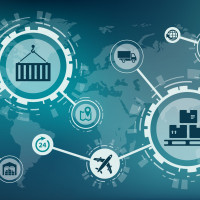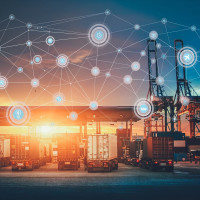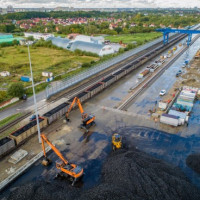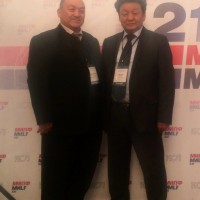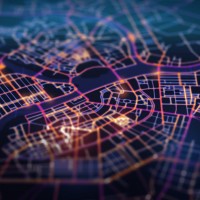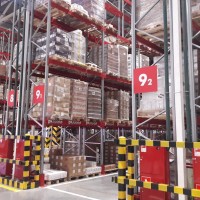The use of ecological transport as a way to promote green logistics in Kyrgyzstan
Keywords: logistics, green economy, environmental requirements, electric transport, electric vehicle, environment, air emissions, transport infrastructure.
Abstract
The proposed study analyzes the relevance and problems of environmental pollution in the Kyrgyz Republic. The air quality in the Chui Valley and especially in the capital, Bishkek, has significantly deteriorated, which negatively affects the health of residents. Bishkek, with a population of more than 1 million, has significant problems with air pollution from automobile emissions. The use of green logistics approaches made it possible to identify the main source of pollution. The most intense source of air pollution in Bishkek is cars. A set of measures to reduce emissions into the atmosphere is proposed, including changing people's consciousness and responsibility to reduce emissions, promoting electric transport. Urban passenger transport is of great socio-economic importance. That is how it can greatly influence the mindset of the population and the promotion of electric transport, since passengers use transport daily and all its improvements immediately become the subject of evaluation. An assessment of the minimum costs for the implementation of the proposed measures was carried out. A plan for the development of electric transport and transport infrastructure is proposed, including the stage of a pilot project and technical tests, as well as economic assessments and proposals.
Introduction
The purpose of this study was to identify approaches and methods of green logistics for the study of environmental problems of Bishkek and the Kyrgyz Republic in general and to propose measures to improve air quality, in particular the use of electric transport and urban electric passenger transport in particular.
Studies have shown that the sustainable development of communities and the urban environment requires the use of green technologies and the desire to create a low-carbon society [1]: To achieve the goal, the united efforts of the government, the private sector and research intuition are of paramount importance for transforming scientific results into the achievement of the Sustainable Development Goals (SDGs). The Special Volume (SV) accepts and reviews a wide range of green initiatives aimed at achieving the SDGs. This PROJECT includes fundamental research on alternative fuels, smart and environmentally friendly materials to reduce waste and environmental impact; technology system design tools to develop sustainable consumption and production for communities; a sustainable waste management system; a circular economy and incentive strategies, for example, through public policy and smart partnerships.
In [2], the use of the principles of green logistics for clean air is investigated:
The dynamic development of cities requires the effective solution of environmental problems that often arise as a result of the implementation of logistics processes of supply, production and distribution. Currently, the main goal of activities carried out with the help of logistics is to minimize the negative consequences of people's economic and residential activities, including external effects (for example, congestion, environmental pollution), while increasing logistical benefits, such as reducing costs and improving customer service (Ambrosino and Siomachen, 2014). Pure logistics process-this becomes the main element of logistics activity (Kadlubek, 2015). A systematic approach in logistics allows you to organize such activities that exclude the collision of environmental and economic goals. Green logistics emphasizes air protection. Relevant research and "green" supply chains are mainly aimed at achieving economic, environmental and social results (Subramanian and Gunasekaran, 2015). Thus, the concept of green logistics favors solutions leading to the implementation of all sustainable development goals, not just environmental ones. Green logistics covers activities focused on: environmental logistics management, low-carbon warehousing and packaging, low-carbon transportation, fleet management, alternative energy and logistics innovation (Zhang, Thompson, Bao and Jiang, 2014). Other goals of green logistics relate to reducing external costs due to climate change, air pollution, noise, vibration and accidents (Jedliński, 2014). Transport is one of the main sources of air pollution in the city. Therefore, green logistics should be supported by the urban logistics strategy " effective management of urban cargo transportation and other traffic flows, in order to achieve an optimal compromise between ensuring optimal logistics networks performance, reliable customer service and reducing environmental impacts, air pollutants, energy consumption and traffic congestion” (Amaral and Aghezzaf, 2015).
The increase in the urban population and economic development lead to more air pollution in cities, which means a danger to health and a deterioration in the quality of life. For this reason, the city authorities should adjust the city's economic, residential and transport processes in such a way as to prevent air pollution. This approach is consistent with the concept of green logistics, which is aimed at reducing emissions, reducing waste and low energy consumption. In this paper, transport and especially freight transport is recognized as the main polluter.
The problems of sustainable development and the use of green technologies are considered in the study [3]: A special volume (SV) accepts and considers a wide range of green initiatives aimed at achieving the goals of sustainable development. This PROJECT includes fundamental research on alternative fuels, smart and environmentally friendly materials to reduce waste and environmental impact; tools for designing technological systems to develop sustainable consumption and production for communities; a system for sustainable waste management; circular economy and stimulating strategies, for example, through public policy and reasonable partnership. Thus, an integrated approach is needed for the intended environmental goals.
Ways to reduce the carbon emissions of passenger transport: the impact on the climate budget of India are investigated in [4]: an assessment of transport emissions with electric vehicles, electric networks (EG) and T&D losses was carried out. It is concluded that electric vehicles are unsuitable without increasing the efficiency of EG and T&D losses. Eleven different scenarios with estimated uncertainties for passenger traffic in the Mumbai metropolitan regions are formulated. The study also shows that the introduction of electric vehicles into the city without simultaneously improving EG will lead to an increase in net CO2 emissions. However, this work does not consider other emissions other than CO 2.
The next study devoted to the problems of the impact of transport on the urban environment is [5]: the opening and gradual expansion of the regional express railway (RER) in the period from 1970 to 2000 in the Paris metropolitan region. The causal influence of urban railway transport on the location of firms, employment and population growth is considered. Thus, the relationship between transport, residential and business infrastructure is obvious. The study [6] is devoted to the same problem, in which a strong negative relationship between emissions and land use rules was found. By limiting new developments, the cleanest areas of the country seem to be pushing new developments to places with higher emissions. Cities usually have significantly less emissions than suburbs, and the gap between the city and the suburbs is especially large in older areas such as New York. Here, emissions from driving, public transport, heating homes and using electricity at home are considered.
The experience of China [7] on the introduction of restrictions on driving transport in Beijing on individual behavior during trips is interesting. The restrictions prohibit drivers from using their cars one weekday a week on the basis of a license plate. This experience of organizational measures also contributes to reducing the number of cars in operation, which means it can reduce the amount of emissions into the atmosphere.
Assessment of the impact of air pollution from transport in urban areas - an overview of the actual data was performed in [8]: a comprehensive review of studies on measurements of concentrations of pollutants in the microenvironment of urban transport, published in the period from January 2016 to July 2020 in the Medline, Scopus and Embase databases, was conducted. The average values and ranges of impacts for each mode of transport were calculated, as well as the impact ratios between modes of transport and factors within the same study.
The results obtained indicate that higher concentrations of air pollutants are often observed in road transport compared to cycling and walking. Therefore, taking into account the broader and long-term benefits for public health and the environment, it is concluded that every effort should be made to prioritize active travel and public transport and allow more people to use these modes of transport. This confirms the role of public transport in the implementation of tasks to reduce emissions.
The problems of air pollution and the concerns caused by it among urban residents are studied in [9]: residents begin to adapt their behavior when traveling and take into account the quality of local air when choosing a house. A spatial and integrated model of choosing the location of residential buildings and transport for a city with air pollution due to traffic is proposed. Intra-urban spatial models of population density, choice of mode of transport and the resulting impact on the population are analyzed for urban conditions with different levels of health hazards and information about air pollution available to residents. This work highlights the need to link information about people's problems related to air pollution and integrated land use and transport measures. In this context, the health benefits are the result of a decrease in population density near urban centers.
Thus, many studies have been devoted to the problems of air pollution and decarbonization. Various approaches to reducing the level of pollution are proposed, one of which is the use of electric transport, both public passenger and personal. In the Kyrgyz Republic, in order to stimulate the use of next-generation transport-electric vehicles by citizens of the Kyrgyz Republic, the Ministry of Economy of the Kyrgyz Republic has developed an Action Plan to stimulate the use of wheeled vehicles with electric motors and the creation of charging infrastructure [10]: Within the framework of the EAEU, it was decided to reset the rates of import customs duties of the Unified Customs Tariff of the EAEU until 31.12.2021. A proposal has been made to the EAEU to extend until 2025 the deadline for resolving the issue of applying a reduced unified rate of customs duties and taxes in respect of electric vehicles imported by individuals for personal use, since after the expiration of this decision, the rates of import customs duties will be paid according to the Unified Customs Tariff of the EAEU in the amount of 15% of the customs value. The Center for Standardization and Metrology under the Ministry of Economy of the Kyrgyz Republic is working on the standardization of electric charging devices and the introduction of international standards IEC 61851 and IEC 62196 into the national system of standards, and is also working on the classification of electric charging stations by type. Together with the Bishkek City Administration, the issue of the proposed location of the electric charging infrastructure within the city of Bishkek is being considered.
The analysis of the current state of urban passenger transport was carried out by the Japan International Cooperation Agency (JICA) in 2013 [11]: it was concluded that a competent policy for the development of the city and the development of public transport is currently being carried out. "Public Transport Development Plan". In such conditions, public transport should play a key role in servicing the movements of citizens. Today, 70% of all public transport operations are carried out by private carriers on minibuses. Municipal transport is uncompetitive due to a less developed route network, high traffic intervals, outdated infrastructure and poor quality of rolling stock operation. The disadvantage is also the lack of a legal framework for the management of the transport complex, which is why management processes are carried out manually, and any planning is impossible. At the moment, private carriers, which carry out 70% of transportation, are actually ignored by the public authorities. Therefore, to normalize the work of public transport and improve the quality of its services, first of all, a reform of the management system is required with the establishment of fair relations with private carriers, and not the development of infrastructure or attempts to oust private carriers from the market through the development of municipal transport. It is important to note that in a city like Bishkek, the construction of expensive rail transport is not required: a tram, a high-speed tram or a metro.
According to the experience of Russian cities with a similar population (Yekaterinburg, Kazan, Nizhny Novgorod), it can be assumed that the construction of even one metro line can take 20-30 years and will require huge investments in infrastructure, and as a result will not improve the conditions of movement. According to our estimate, one north–south metro line in Bishkek will be able to serve only 6-8% of all movements.
As world experience shows, the lack of rail infrastructure can be a competitive advantage, since it simplifies the development of bus systems.
In the draft concept for the development of Bishkek [12]: it is proposed to redirect the vector of the city's development from the horizontal (expansion of administrative borders, integrated development of undeveloped territories) to the vertical (intensification of the use of already built-up territory and stimulating the development of the city within the existing administrative borders). The parameters of land use in our project are linked to the development of public transport, which allows us to plan and optimize the load on the transport infrastructure. As you move away from the city center and the main lines of passenger transport, the density and number of floors of the building decreases (Fig. 1).
The second section of this study is devoted to the problems of transport: the Bishkek street and road network has insufficient density, which is why the type of urban mobility based on the predominant use of personal vehicles cannot be stable and comfortable. In cities with similar parameters of the road network, international practice recommends imposing serious restrictions on the ownership and use of motor vehicles in order to shift the transport demand to other types of transport (Fig.2). In such conditions, public transport should play a key role in servicing the movements of citizens. Today, 70% of all public transport operations are carried out by private carriers on minibuses.
Fig. 1 Conceptual scheme of the city development/ source: research of the author's team
Fig. 2. The existing street and road network of Bishkek / Source: Research of the author's team
At the same time, the existing route networks of municipal public transport - bus and trolleybus lines are proposed in Fig. 3.
Fig. 3 Operating route networks of municipal transport in Bishkek
According to the results of this study, it can be concluded that the development of the route network and transport infrastructure as a whole is lagging behind the pace of development of the city.
The Government of the Kyrgyz Republic is making efforts to improve the situation in the field of passenger transport in Bishkek, including reducing harmful emissions. In August 2020, a memorandum of understanding was signed between the Asian Development Bank (ADB) and the Ministry of Finance of the Kyrgyz Republic on the urban transport electrification project [13].
The use of electric buses in Kyrgyzstan is a new and unfamiliar business. The paper [14] presents the result of the analysis of the efficiency and applicability of various options of electric passenger transport in the city. Technologies of electric buses-electric buses: electric buses with power in motion (In-Motion-Feeding), electric buses with charging in motion (In-Motion-Charging), electric buses with charging on the route (Opportunity Charging), electric buses with charging at the depot/station (Overnight Charging). "Disadvantages" of trolleybuses-IMF electric buses:
1. Power supply system: traction substations, feeding feeders, contact network-costs
2. Visual pollution (?)- aesthetics
3. Complex intersections of the contact network-costs, aesthetics
4. Fixed route network (?) –passenger confidence
5. Low maneuverability (?) –2-3 lanes
6. Reliability of the power supply and current collection system! - prevention and improvement
A comparison of different types of electric buses on the energy efficiency of transportation was made (Table 1)
Passenger capacity / energy efficiency of transportation Table 1
Passenger capacity, people
Energy per passenger, W*h/(pass*km)
Mass of the drive, kg
IMF
100
25
-
IMC
95
26
312,5
OC
81
30
1250
ONC на тягу
26
96
5000
56
45
3000
From a technical point of view, all these options are very similar – a bus-type body and chassis, a traction electric motor, control devices and electric energy supply. The differences in the cost of various electric bus designs are mainly determined by the capacity, size and weight of the batteries. Which concept of an electric bus is most suitable for your city? To do this, it is proposed to take into account the specific conditions and resources of the city.
A comparison of electric bus variants was made in the study [15]: Our analysis shows that a diesel bus running on conventional diesel remains the most economical technology until 2025, while the regulatory framework remains unchanged. But this contributes very little to the achievement of the central goals of the German government. "Mobility and Fuel Strategy" (MFS), for example, reducing energy consumption and greenhouse gas emissions or introducing new technologies. On the contrary, electric buses could make a significant contribution to achieving these goals. With the progress in the energy transition ("Energiewende") and the further development of the battery, the technology of electric buses will become more profitable, especially from an environmental point of view. For electric buses, IMC is considered as the most economical technology for high-capacity lines (frequent maintenance, high-capacity vehicles) or lines with high energy demand. On the other hand, it is necessary to take into account all emissions into the atmosphere: exhaust gas emissions and emissions into the upper atmosphere during the production of energy carriers. Exhaust pipe emissions of conventional buses are calculated using the "Manual Database of Emission Factors for Road Transport" (HBEFA, version 3.2).
The emissions of the electric bus use phase are determined by the production of electricity. The structure of electricity production is based on the work of AG Energiebilanzen , the Bundesverband Erneuerbare Energien (German Federation of Renewable Energy Sources)and the Fraunhofer Institut für Solare Energiesysteme (Fraunhofer Institute for Solar Energy Energy Systems). Future electricity mixes are based on the 2011 Leitstudio. The calculated emission factors for electricity generation include emissions from power plants and primary energy supplies. An analysis of greenhouse gas emissions from the production of buses themselves was also carried out. Greenhouse gas emissions: All alternative concepts have increased emissions at the production stage compared to the diesel bus. They are strongly influenced by the size of the batteries in the corresponding electric bus concept. But also fuel cell hybrid buses have significantly higher emissions due to the production of vehicles. The higher fuel cell emissions are mainly due to the carbon fiber reinforced polymer (CFRP) used in the hydrogen tank and the platinum used in the fuel cell. More efficient production processes for the production of carbon fiber, the use of electricity with a higher proportion of renewable energy sources and a higher proportion of recycled platinum can reduce these environmental consequences in the future. Thus, IMC is considered as an integral part of the strategy of electrification of urban public transport. The choice was made in favor of the IMC strategy at the current stage of technology and technology development.
The choice of IMC technology electric buses was also made for San Francisco [16]: the city is expanding its fleet of zero-emission transit buses: after purchasing 93 Xcelsior XT60 articulated electric buses, the San Francisco Municipal Transit Agency (SFMTA) placed an order for 185 New Flyer XT40 buses equipped with the In Motion Charging (IMC) system, technology from Kiepe Electric. With the In Motion Charging function, trolleybuses cover sections of the route without overhead lines in battery-powered mode, and the batteries are then charged when the vehicle is again under the overhead lines. They are designed to improve the ride of passengers and reduce the impact on the environment. These new buses will serve passengers on the most mountainous and busiest routes of the city.
2. Materials and Methods
* The assumptions made and their justification
* Statistical and mathematical procedures used for data analysis and generalization.
The methods used should be described, as a rule, in chronological order, with the necessary accuracy and details. Standard methods should only be mentioned or can be described with reference to the literature. If the method is new, it should be described in detail.
Bishkek, with a population of more than 1 million, has significant problems with air pollution from automobile emissions. The most intense source of air pollution in Bishkek is cars. The annual total volume of emissions of pollutants into the atmosphere of Bishkek is 240 thousand tons, of which 180 thousand tons of pollutants are accounted for by cars. The number of cars registered in the city exceeds 500 thousand, of which there are less than 100 electric cars.
Bishkek, with a population of more than 1 million, has significant problems with air pollution from automobile emissions. The most intense source of air pollution in Bishkek is cars. The annual total volume of emissions of pollutants into the atmosphere of Bishkek is 240 thousand tons, of which 180 thousand tons of pollutants are accounted for by cars. The number of cars registered in the city exceeds 500 thousand, of which there are less than 100 electric cars.
As a solution, the mayor's office sees an increase in the fleet of public municipal transport to 60%-70%, this is an additional 400-600 units. large class buses (45-60 seats), which will optimize the quality and streamline the traffic flows of the capital's streets. The city administration is taking measures to improve the environment – buses with gas engines were purchased, which reduces harmful exhaust emissions. Efforts are also being made to expand the trolleybus fleet. However, the use of electric buses is a new and unfamiliar business for them, it is necessary to conduct special research and widely promote the use of electric transport first on passenger transport, then everywhere.
An assumption was made about the effectiveness of the introduction of IMC electric buses in Bishkek with the aim of expanding the transport network and reducing air pollution and promoting green logistics in the Kyrgyz Republic. The following studies were also carried out: a survey of the structure of the rolling stock of public transport, including a study of the situation with trips on various types of transport, and a rational structure was recommended; the analysis of the trolleybus network is carried out in order to cover the outskirts of the city with trolleybus communication through the use of trolleybuses with increased autonomous travel.
The study used econometric methods based on open source data, as well as data from our own research, data from expert analysis and a survey of the population.
3 Results
1. In the Kyrgyz Republic, in addition to small hydroelectric power plants, 18 electric power plants with a total installed capacity of 3,678 MW are operated, including 16 hydroelectric power plants and 2 thermal power plants. The share of HPP electricity generation is 88.5% of the total production [17]. With such a structure of electricity production, emissions into the upper atmosphere during the production of energy carriers are minimal, therefore, exhaust gas emissions from cars are the main air pollutant and the object of the impact of green logistics.
2. To select the recommended type of passenger electric transport, a classification of technical variants with averaged characteristics is compiled in Table 2.
Classification of types of electric transport Table 2
Trolleybus (with minimal autonomous running)\ Electric bus with power in motion
Electric bus with charging in motion (trolleybus with increased autonomous travel)
Electric bus with charging at stops
Electric bus with charging at the depot
Name of the technology
IMF (In-Motion-Feeding)
IMC (In-Motion charging)
OC (Opportunity charging)
ONC (Overnight charging)
Energy storage method
-
Charging when driving on a section equipped with a contact network
Ultra-fast charging on the route during part of the stops
Night slow charging
Autonomous power reserve
before 2 км
5 — 70 км
20 — 70 км
more 150 км
Easy to charge
Absent
Absent
5-25 minutes (at the bus stop)
4-10 hours (at the depot)
The known disadvantages of the trolleybus are the binding to the contact network and the cost of the network itself. The contact network, together with cable lines and traction substations, is an expensive infrastructure object that requires significant investments in construction and maintenance. The construction of contact networks is quite high. Therefore, it is proposed to use the IMC option for Bishkek. In countries where the lines of the classic trolleybus have been preserved, the option of a "partial" trolleybus is justified, i.e. trolleybuses with autonomous running from batteries are a very profitable solution.
3. For Bishkek, on the basis of the city development scheme (Fig.1), the route network of municipal transport of the trolleybus carrier (Fig. 3b), the study of mobility and population of peripheral zones, the possibilities of extending trolleybus routes from final stops to residential areas using IMC were calculated (Table 3).
The possibility of extending existing routes Table 3
#
Name of the destination
Route numbers
Residential areas that fall within the area of additional coverage
Lengthening of the route, km
1
Microdistrict "Jal"
5,14,1
Archa-Beshik, Chon-Aryk
5-6
2
Residential area "Ak-Orgo"
7,8,9,16
Selection, Ak-Ordo
6-7
3
Microdistrict "Asanbay"
10,11,17,13,15
Kok-Zhar, Beshkungey village
5-6
4
Residential district "Alamedin-1"
9,15,2
Novopokrovka village
8
5
Dordoy Market (Leather Factory)
4,17
Kelechek, Dordoi
5
The lengthening of routes is insignificant and is easily overcome by trolleybuses on autonomous travel, which pull over part of the passenger traffic in residential areas. Thanks to the introduction of the new product, trolleybus routes can be extended by 30-40 km, and the trolleybus route network can be expanded due to the possibility of movement from one trolleybus line to another. Buses, the route route of which partially coincides with the trolleybus, it will be advisable to replace them with trolleybuses. This improves the quality of passenger service and the role of public passenger electric transport. As can be seen from the table, the lengthening of routes can be 5-7 km, up to a maximum of 10 km from the existing final stop. The cost of building 1 km of a standard trolleybus network can reach 400 thousand US dollars, so the use of trolleybuses with a large autonomous course is a good alternative to the construction of new contact networks.
Since the average cost of a trolleybus with an increased autonomous course for the CIS market is $ 182500 and is quite significant for Kyrgyzstan, as an alternative, you can use the option of converting existing trolleybuses of modern design into a trolleybus with an increased autonomous course. Such experience has been accumulated in the regions of the Russian Federation. At the heart of the alteration is the installation of lithium-ion batteries, a controller and an automatic lifting device for connecting to the contacts. The cost of reworking is about 22 thousand US dollars. Rework kit: a new electronic drive and 42 lithium-ion batteries, weighing about 1000 kg. An autonomous course of 15-20 km is provided, depending on the load. The Bishkek trolleybus fleet has 37 units of the 2018 Optima Trolleybus 5275.03 (RF) and 33 trolleybuses of the VMZ-5298.01-50 Avangard brand of Belarusian production (2013) as potential objects for re-equipment.
4 Discussion
It is in this section that the authors explain the meaning and significance of the results obtained. This section brings everything together, shows the importance and value of the work and, therefore, is the most innovative and difficult part of the article to write.
There are significant problems with air pollution from automobile emissions in Bishkek, but no active measures are being taken to solve these problems. First of all, of course, because of the lack of funding for the projects announced by the government. However, promoting the ideas of a green economy is no less important task. The efforts of both the Government and local communities and civil society are necessary. Urban passenger transport is of great socio-economic importance. It can greatly influence the mindset of the population and the promotion of electric transport, since passengers use transport daily and all its improvements immediately become the subject of evaluation and promotion.
The next stage of research may be the idea of converting minibuses, which provide 70% of urban passenger traffic, into an electric car, which would also help reduce air pollution. The main obstacle is of course the cost of rework, which can reach 20-30 thousand US dollars. However, the components of the systems can be produced in Belarus and Russia, and the batteries can be purchased in China, which can reduce costs. It is possible to localize the production of individual components in Kyrgyzstan to reduce costs.
Further implementation of the principles of the green economy can be the development of other types of renewable energy sources – wind energy and solar. There are potential opportunities for installing wind turbines in many places of the republic, and according to the number of sunny days per year (247), Kyrgyzstan also has great prospects for the development of solar energy.
Conclusions
In the Kyrgyz Republic, there is a need and there are prerequisites for the introduction of the principles of a green economy;
The main driver of the ideas of ecological consciousness and decarbonization should be the project of introducing public passenger electric transport;
It is necessary to develop other types of renewable energy sources in the republic.
References
[1] How circular economy and green technology can address Sustainable Development Goals?
Edited by Jeng Shiun Lim, Yee Van Fan, Chunjie Li
Last update 1 May 2021 https://www.sciencedirect.com/journal/journal-of-cleaner-production/collection/10RMVSP1ZQQ?page-size=100&page=1
[2] Agata Mesjasz-Lech, Urban air pollution challenge for green logistics, 2nd International Conference "Green Cities - Green Logistics for Greener Cities", 2-3 March 2016, Szczecin, Poland, Transportation Research Procedia 16 ( 2016 ) 355 – 365 https://www.researchgate.net/publication/310779353_Urban_Air_Pollution_Challenge_for_Green_Logistics
[3] Jeng Shiun Lim, Yi Wan Fan , Chunji Lee How can the closed-loop economy and green technologies contribute to the achievement of the Sustainable Development Goals?, Journal of Cleaner Production. May 1, 2021
https://www.sciencedirect.com/journal/journal-of-cleaner-production/special-issue/10RMVSP1ZQQ
[4] Deepjyoti Das, Pradip P.Kalbar, Nagendra R.Velaga Pathways to decarbonize passenger transportation: Implications to India’s climate budget, Journal of Cleaner Production Volume 295, 1 мая 2021 г. , 126321 https://www.sciencedirect.com/science/article/abs/pii/S0959652621005412
[5] Thierry Mayera, CorentinTrevien The impact of urban public transportation evidence from the Paris region,
Journal of Urban Economics Volume 102, November 2017, Pages 1-21, https://www.sciencedirect.com/science/article/abs/pii/S0094119017300608
[6] Edward L Glaeser, Matthew E.Kahn, The greenness of cities: Carbon dioxide emissions and urban development.
Journal of Urban Economics Volume 67, Issue 3, May 2010, Pages 404-418
https://www.sciencedirect.com/science/article/abs/pii/S0094119009001028
[7] Yizhen Gu, Elizabeth Deakin, Ying Long, The effects of driving restrictions on travel behavior evidence from Beijing, Journal of Urban Economics, Volume 102, November 2017, Pages 106-122
https://www.sciencedirect.com/science/article/abs/pii/S0094119017300244
[8] Christina Mitsakou,James P.Adamson,Artemis Doutsia Huw Bruntb Sarah, J.Jonesb Alison M. Gowersa Karen S. Exleya, Assessing the exposure to air pollution during transport in urban areas – Evidence review,
Journal of Transport & Health Volume 21, June 2021, 101064
https://www.sciencedirect.com/science/article/abs/pii/S2214140521000943
[9] Mirjam Schindler, Judith Y.T. Wang, Richard D. ConnorsA, Two-stage residential location and transport mode choice model with exposure to traffic-induced air pollution, Journal of Transport Geography, Volume 93, May 2021, 103044
https://www.sciencedirect.com/science/article/abs/pii/S0966692321000971
[10] Продвижение принципов Зеленой экономики в КР: стимулирование использования экологического транспорта на электрической тяге http://mineconom.gov.kg/ru/post/6597
[11] Исследование по совершенствованию городского пассажирского транспорта в г. Бишкек, Кыргызская Республика. Заключительный отчет. Краткий обзор. — Японское агентство международного сотрудничества (JICA). 2013 г. https://openjicareport.jica.go.jp/pdf/12127627_01.pdf
[12] О. Таловская, А. Рыжков, Н. Хорт Бишкек: Проект — концепция модели развития до 2040 года
https://urban.hse.ru/bishkek2040
[13] В Бишкеке появятся электробусы? https://kaktus.media/doc/418681_v_bishkeke_poiaviatsia_elektrobysy_podpisan_pervichnyy_dogovor_s_abr.html
[14] С. Корольков, «Электробус – технические особенности вариантов исполнения». Троллейбусный комитет МСОТ. МОСГОРТРАНС (8 сентября 2017).
https://docplayer.ru/57047153-Elektrobus-tehnicheskie-osobennosti-variantov-ispolneniya.html
[15] Fabian Bergk Kirsten Biemann Udo Lambrecht Ralph Pütz Hubert Landinger. Potential of In-Motion Charging Buses for the Electrification of Urban Bus Lines (англ.) // Journal of Earth Sciences and Geotechnical Engineering. — 2016.
http://www.scienpress.com/Upload/GEO/Vol%206_4_21.pdf
[16] IMC® electric buses on trend in the USA: Kiepe Electric to supply 185 systems for San Francisco
https://www.automotiveworld.com/news-releases/imc-electric-buses-trend-usa-kiepe-electric-supply-185-systems-san-francisco/
[17] Электроэнергетика Кыргызстана https://www.energycharter.org/fileadmin/DocumentsMedia/Events/20070426-Bishkek_Kyrgyzstan_Nazarov-ru.pdf
